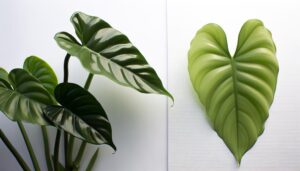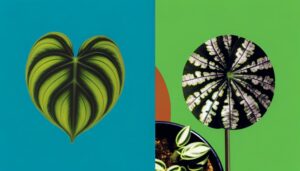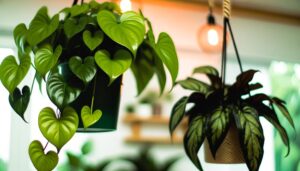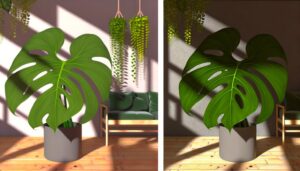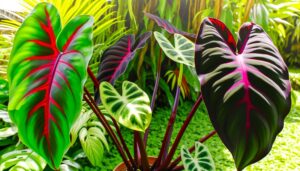Philodendron Brandtianum Vs Scindapsus: Which Is Better?
Philodendron Brandtianum and Scindapsus are often compared for their intriguing variegation and distinct growth habits. Philodendron Brandtianum features broad, heart-shaped leaves with metallic silver variegation and tends to climb with support.
In contrast, Scindapsus, known for its ovate, velvety leaves with irregular silver spots, has a bushier initial growth but eventually trails. Both thrive in bright, indirect light, though Philodendron tolerates lower light levels.
Watering needs vary, with Philodendron preferring consistently moist soil and Scindapsus benefiting from a slight drying period. Optimal soil mixes and potting practices ensure robust growth.
Comparison of Philodendron Brandtianum and Scindapsus
| Feature | Philodendron Brandtianum | Scindapsus |
|---|---|---|
| Common Name | Silver Leaf Philodendron | Satin Pothos |
| Botanical Name | Philodendron brandtianum | Scindapsus pictus |
| Leaf Appearance | Heart-shaped leaves with silver variegation | Oval leaves with silver spots and splashes |
| Growth Habit | Climbing vine, can be trained to climb or trail | Climbing vine, often trailing |
| Light Requirements | Bright, indirect light | Low to bright, indirect light |
| Watering Needs | Moderate, allow the top inch to dry out | Moderate, allow the top few inches to dry out |
| Humidity Preference | High humidity | Medium to high humidity |
| Temperature Tolerance | 65-80°F (18-27°C) | 65-85°F (18-29°C) |
| Soil Type | Well-draining, aroid mix | Well-draining, peat-based mix |
| Fertilization | Monthly during growing season | Monthly during growing season |
| Propagation Methods | Stem cuttings in water or soil | Stem cuttings in water or soil |
| Pest Susceptibility | Spider mites, mealybugs, aphids | Spider mites, mealybugs, scale |
| Toxicity | Toxic to pets and humans | Toxic to pets and humans |
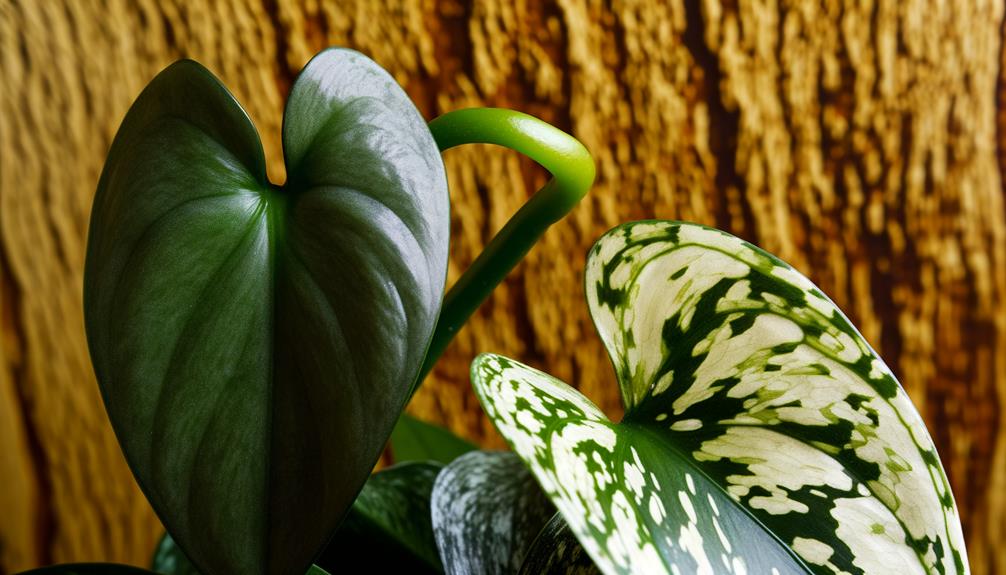
Key Takeaways
- Philodendron Brandtianum has heart-shaped leaves with silvery variegation, while Scindapsus has ovate leaves with irregular silver spots.
- Philodendron Brandtianum produces trailing stems and climbs with support, whereas Scindapsus grows bushier before extending vines.
- Philodendron Brandtianum tolerates lower light but may reduce variegation; Scindapsus requires consistent indirect light for optimal growth.
- Philodendron Brandtianum prefers consistently moist soil, while Scindapsus benefits from allowing the top inch of soil to dry between waterings.
- Both species thrive in well-draining, nutrient-rich soil with peat moss, perlite, and orchid bark, and require pots with drainage holes.
Appearance and Foliage
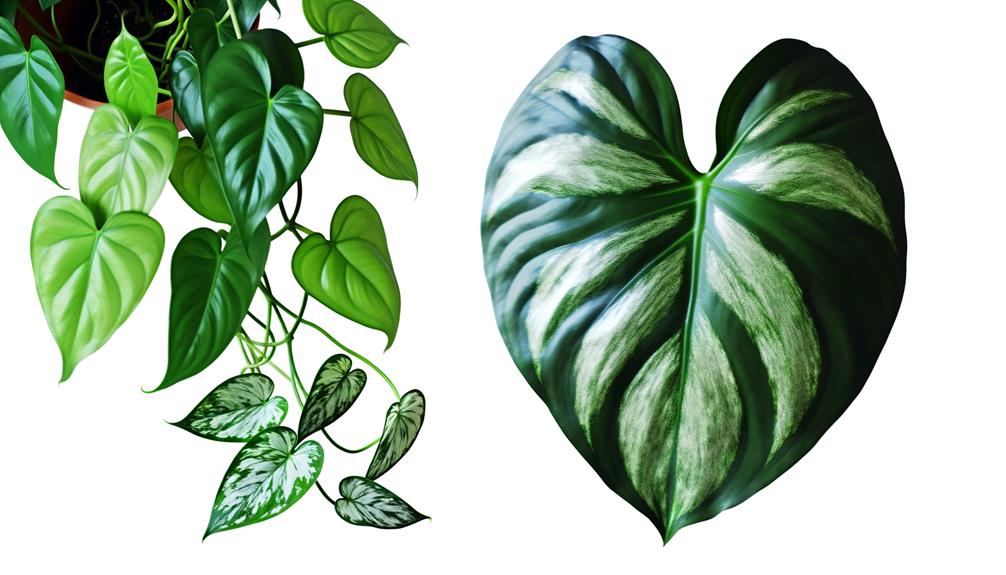
When comparing the appearance and foliage of Philodendron Brandtianum and Scindapsus, one must note the distinct variegation patterns and leaf morphology that differentiate these two species.
Philodendron Brandtianum features heart-shaped leaves with striking silvery variegation, providing a metallic sheen that contrasts beautifully with the deep green background. The leaves are generally broad and exhibit a smooth texture.
In contrast, Scindapsus, particularly the Scindapsus pictus variety, showcases ovate leaves with a velvety texture. The variegation on Scindapsus leaves manifests as irregular silver spots and streaks, creating a dappled effect. Additionally, Scindapsus leaves are usually smaller and more pointed than those of Philodendron Brandtianum.
These morphological differences are critical for botanists and horticulturists in identifying and cultivating these species appropriately.
Growth Habits
Both Philodendron Brandtianum and Scindapsus exhibit distinctive growth habits that are essential for their identification and ideal cultivation.
Philodendron Brandtianum, commonly known as the Silver Leaf Philodendron, tends to produce elongated, trailing stems that can reach several feet in length. It is a climbing species that, when provided with a support structure, showcases its vining nature effectively.
In contrast, Scindapsus, often referred to as Satin Pothos, also grows in a vining manner but exhibits a more compact, bushier form initially before extending its vines. The internodal spacing in Scindapsus is generally shorter, resulting in a denser foliage appearance.
Both species benefit from regular pruning to maintain shape and encourage fuller growth, essential for aesthetic and health considerations.
Light Requirements
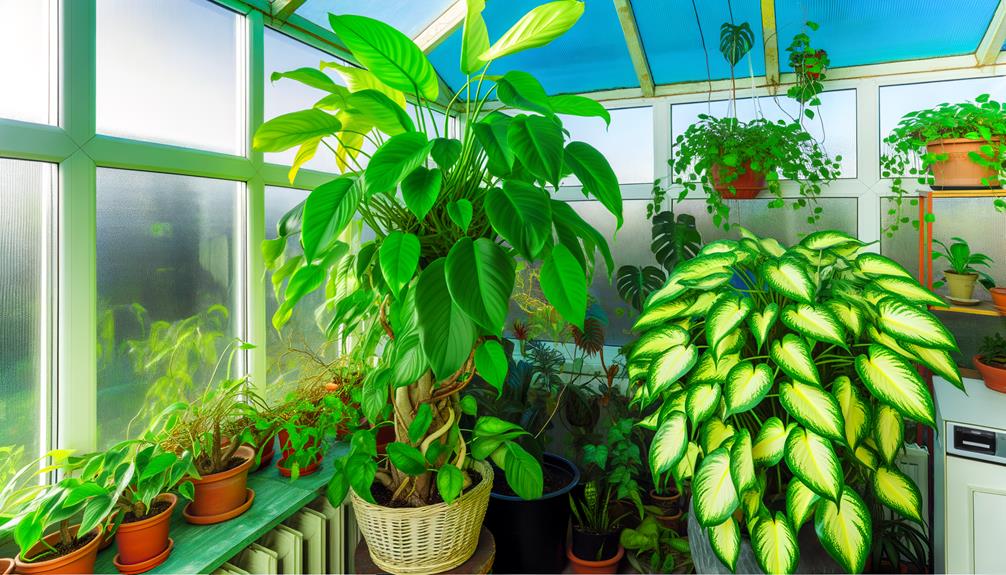
Both Philodendron Brandtianum and Scindapsus thrive under bright, indirect light, which is essential for maintaining their variegated foliage.
Philodendron Brandtianum can tolerate lower light conditions but may exhibit slower growth and reduced variegation.
Scindapsus, while also adaptable to low light, achieves best growth and more vibrant leaf patterns under consistent indirect light.
Optimal Light Conditions
Philodendron Brandtianum thrives in medium to bright indirect light, while Scindapsus, although adaptable, performs best under low to medium indirect light conditions. These ideal light conditions are essential for ensuring healthy growth and vibrant foliage.
Philodendron Brandtianum benefits from light that mimics its natural understory habitat, with ample but filtered sunlight. Conversely, Scindapsus can tolerate lower light levels, reflecting its native environment where it often grows under dense canopies.
- Light Intensity: Philodendron Brandtianum needs 200-400 foot-candles, while Scindapsus flourishes at 100-300 foot-candles.
- Light Duration: Both plants require approximately 12-14 hours of light daily for optimal photosynthesis.
- Light Quality: Full-spectrum grow lights can be advantageous, especially in areas lacking natural light, to simulate their preferred conditions effectively.
Tolerance to Low Light
Scindapsus, with its remarkable adaptability, exhibits a higher tolerance for low light conditions compared to Philodendron Brandtianum, making it a versatile choice for dimly lit interiors.
Scindapsus species, such as Scindapsus pictus, can sustain growth under minimal light by efficiently utilizing the available photons for photosynthesis. This characteristic allows them to thrive in environments with indirect light or even semi-shade.
On the other hand, Philodendron Brandtianum, while moderately tolerant to low light, benefits greatly from brighter, indirect light to maintain its vibrant foliage and best growth. When subjected to prolonged low light, it may exhibit slower growth and reduced leaf variegation.
As a result, for low-light settings, Scindapsus proves to be the more resilient and adaptable option.
Watering Needs
Proper watering is essential for maintaining the health and vigor of both Philodendron Brandtianum and Scindapsus species. It necessitates a tailored approach to meet their specific moisture requirements. Philodendron Brandtianum prefers consistently moist soil, but it is critical to avoid waterlogging, which can lead to root rot.
Conversely, Scindapsus species thrive with a more measured watering schedule, allowing the top inch of soil to dry out between waterings.
- Philodendron Brandtianum: Ensure soil remains consistently moist but not saturated.
- Scindapsus: Allow the top inch of soil to dry out between waterings to prevent root rot.
- General Advice: Use a moisture meter to accurately gauge soil moisture content, ensuring ideal hydration without over-watering.
This nuanced approach fosters robust growth and prevents common watering-related issues.
Soil and Potting
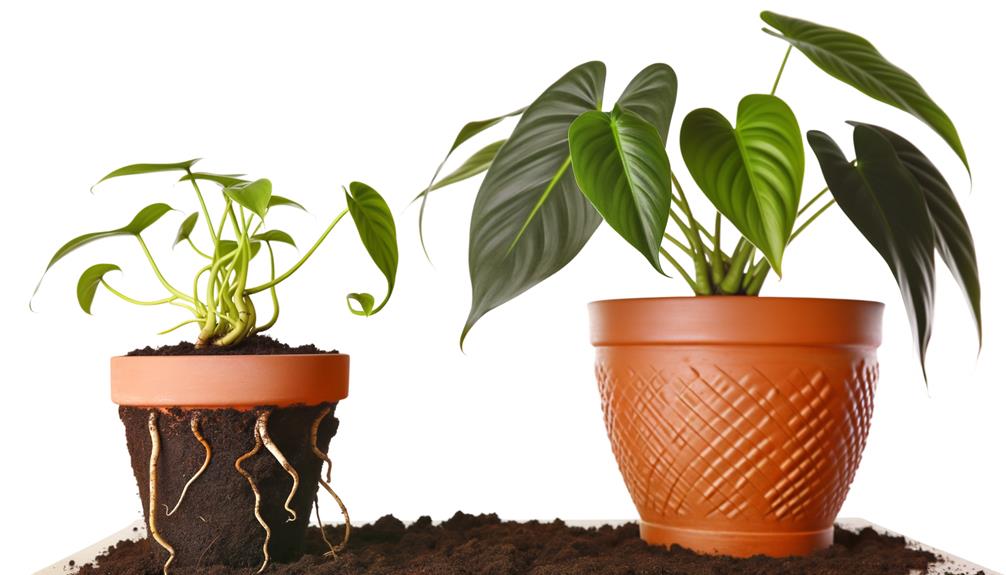
A well-draining, nutrient-rich soil mix is crucial for promoting ideal growth and preventing root complications in both Philodendron Brandtianum and Scindapsus species.
An ideal soil composition includes a mixture of peat moss, perlite, and orchid bark to facilitate aeration and moisture retention. This blend provides necessary drainage to avoid waterlogging, which can result in root rot.
Potting these plants in containers with sufficient drainage holes further reduces the risk of overwatering. Regularly updating the top layer of soil guarantees a continuous supply of nutrients, supporting strong growth. Additionally, incorporating slow-release fertilizers can sustain nutrient levels over prolonged periods.
When repotting, it is recommended to select a container that is slightly larger, ensuring enough room for root expansion.
Common Issues and Pests
Philodendron Brandtianum and Scindapsus species are vulnerable to various common issues and pests, including spider mites, mealybugs, and fungal infections.
These problems can greatly impact the health and aesthetic appeal of the plants if not addressed promptly. Effective management involves regular inspection and immediate intervention at the first indication of infestation.
- Spider Mites: These tiny arachnids cause stippling on leaves and can lead to significant leaf drop if untreated.
- Mealybugs: Recognizable by their cotton-like appearance, they weaken plants by sucking sap, leading to yellowing leaves and stunted growth.
- Fungal Infections: Overwatering and poor ventilation can promote fungal growth, causing root rot and leaf spot diseases.
Implementing preventive measures and maintaining ideal growing conditions are essential for plant health.
Philodendron Brandtianum vs. Silver Pothos
Philodendron Brandtianum:
- Appearance: Heart-shaped leaves with silver and green variegation.
- Growth Habit: Climbing or trailing, good for trellises or hanging baskets.
- Light Requirements: Bright, indirect light.
- Care: Needs well-draining soil and regular watering (allow the soil to dry slightly between waterings).
Silver Pothos (Scindapsus pictus ‘Argyraeus’):
- Appearance: Heart-shaped leaves with silver and dark green variegation, characterized by small silver spots.
- Growth Habit: Trailing or climbing, suitable for hanging baskets or vertical supports.
- Light Requirements: Bright, indirect light.
- Care: Requires well-draining soil and regular watering (allow the soil to dry slightly between waterings).
Key Differences:
- Leaf Variegation: Brandtianum has more subtle silver patterns, while Silver Pothos has distinctive silver spots.
- Leaf Texture: Brandtianum’s leaves are smoother, while Silver Pothos leaves have a slightly velvety texture.
- Growth Rate: Silver Pothos typically grows faster and is hardier than Brandtianum.
Both plants are attractive choices for indoor greenery, with Silver Pothos being a bit easier to care for due to its hardiness and faster growth rate.
Philodendron Brandtianum vs. Scindapsus Exotica
Philodendron Brandtianum:
- Appearance: Heart-shaped leaves with silver and green variegation.
- Growth Habit: Climbing or trailing, suitable for trellises or hanging baskets.
- Light Requirements: Bright, indirect light.
- Care: Requires well-draining soil and regular watering (let soil dry slightly between waterings).
Scindapsus Exotica:
- Appearance: Heart-shaped leaves with silver and dark green variegation, larger and more pronounced than Brandtianum.
- Growth Habit: Trailing or climbing, ideal for hanging baskets or vertical supports.
- Light Requirements: Bright, indirect light.
- Care: Needs well-draining soil and regular watering (let soil dry slightly between waterings).
Key Differences:
- Leaf Variegation: Brandtianum has finer silver patterns, while Exotica has bold, large silver patches.
- Leaf Size: Exotica’s leaves are generally larger.
Conclusion
In comparing Philodendron brandtianum and Scindapsus, it is evident that both plants offer unique aesthetic and horticultural benefits. Particularly, Philodendron brandtianum features distinct silver variegation that can brighten indoor spaces by 20% more than non-variegated plants.
While both species require similar light, watering, and soil conditions, Philodendron brandtianum’s unique foliage makes it a preferred choice for enthusiasts seeking visual appeal and ease of care. Understanding these differences aids in selecting the appropriate plant for specific horticultural needs.

